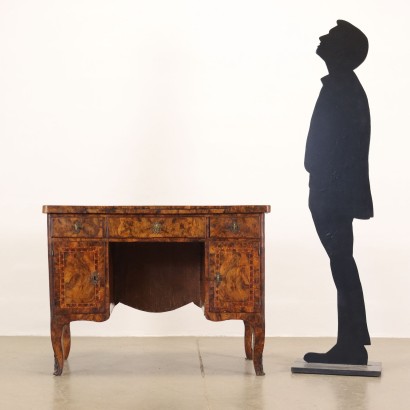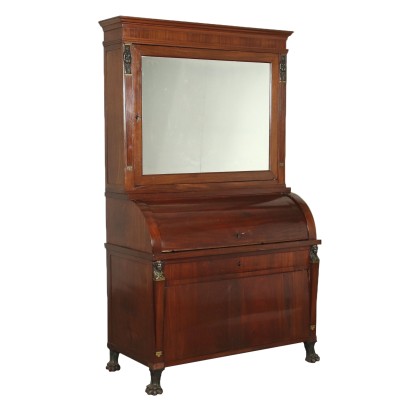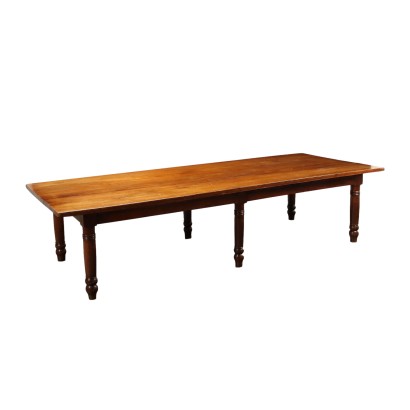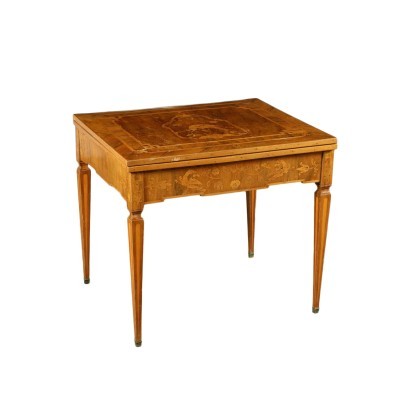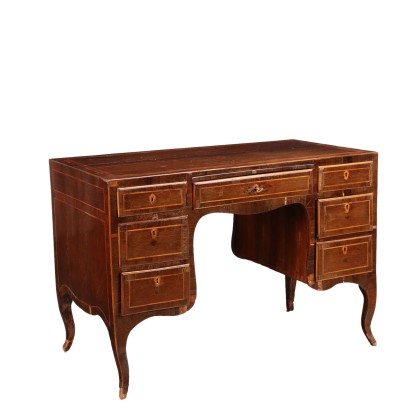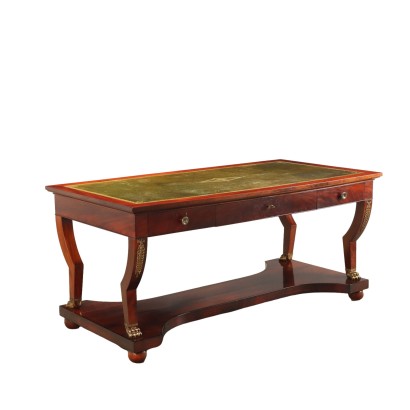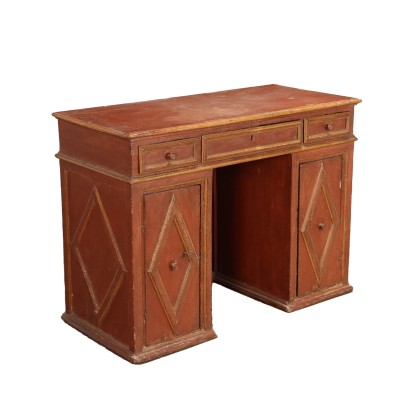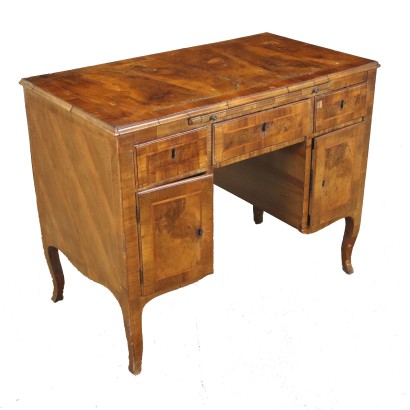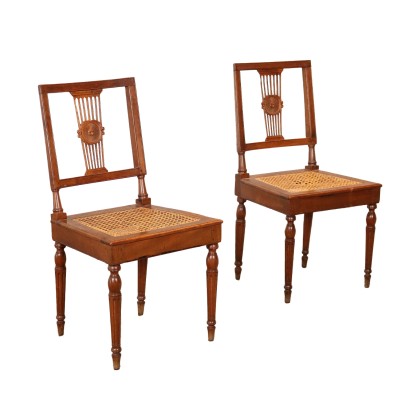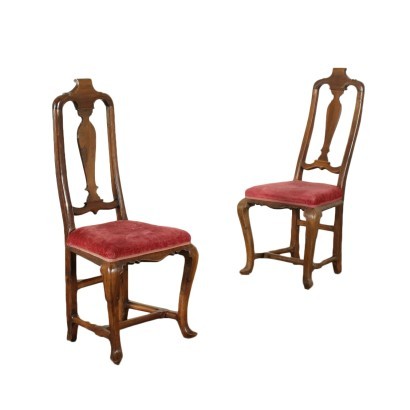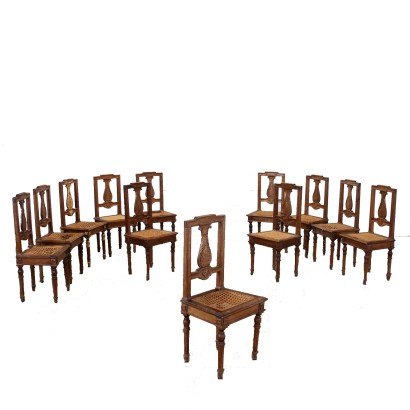Baroque Desk Walnut Italy XVIII Century - Veneto Last Fourth of the 18th Century
Features
Veneto Last Fourth of the 18th Century
Style: Barocchetto (1720-1770)
Age: 18th Century / 1701 - 1800
Origin: Veneto, Italy
Main essence: Silver Fir , Maple , Walnut
Material: Burnished Bronze , Leather , Walnut Burl Slab
Description
Baroque open desk in walnut, Veneto, last quarter of the 18th century. Top with leather insert, drawer and 3 drawers in the band, pair of doors and wavy legs ending with burnished bronze shoes. Inlaid with medallion frames, threaded in maple and veneered in walnut briar. Spruce interior.
Product Condition:
Product that due to age and wear requires restoration and resumption of polishing.
Dimensions (cm):
Height: 81,5
Width: 112,5
Depth: 59,5
Additional Information
Style: Barocchetto (1720-1770)
This term refers, specifically to furniture, to a part of the production carried out in Italy in the period between the Rococo era and the first phase of neoclassicism.It is characterised by the formal and decorative structure still rigidly in adherence to the dictates dear to the Baroque period (hence the term barocchetto) and to the Louis XIV fashions and yet the new times can be seen in the adoption of smaller volumes, more elegant decorative modules, often directly inspired by French fashion, but always executed with rigorous principles of ornamental symmetry.
The tendency to assimilate formal and volumetric innovations but not to incorporate their ornamental elaboration finds a natural explanation in Italy in the fact that in this century the great aristocracy is experiencing an unstoppable political and economic decline.
If in the previous century there was a great profusion of furnishings intended to decorate recently built homes, to proudly show the power of the commissioning family, in In the 18th century, the focus was on updating the building with only the furniture strictly necessary for the new needs imposed by fashion or functional needs.
The old scenographic apparatus was maintained and the new must not contrast too much.
Find out more about the Barocchetto with our insights:
Classic Monday: discovering the Barocchetto
Classic Monday: between Baroque and Baroque
Classic Monday elegant and unusual with two Baroque balustrades
FineArt: Pair of Late Baroque Chairs, Venice
Emilian chest of drawers, first quarter of the 18th century, early Late Baroque
Urn shelf, Milan, mid-18th century
INSERT ADDITIONAL LINKS:
Classic Monday: The Austrian Taste of Baroque
Classic Monday: Pietro Longhi's Baroque
Classic Monday: The Sculptures of the Italian Baroque
Age: 18th Century / 1701 - 1800
18th Century / 1701 - 1800Main essence:
Silver Fir
Soft coniferous wood, used for rustic furniture or to build the chest, that is the structure, of furniture then veneered in more precious woods. It has been used since ancient times, its most valuable use is, in the Spruce variant, in the inlays of French antique furniture of the '700 . The spruce, more typical of northern Europe, in Italy grows mainly in the Eastern Alps at altitudes above 1300 m. The noblest use of this essence was in the construction of violins, guitars and cellos: Stradivari himself produced his famous violins with this wood.Maple
Hard, light wood used for inlays. It grows mainly in Austria, but it is widespread throughout the northern hemisphere, from Japan to North America, passing through China and Europe. It is one of the lightest woods ever, tending to white, it is similar to lime or birch wood. The briar is used in the production of ancient secretaires .Walnut
Walnut wood comes from the plant whose botanical name is juglans regia , probably originally from the East but very common in Europe. Light or dark brown in color, it is a hard wood with a beautiful grain, widely used in antique furniture. It was the main essence in Italy throughout the Renaissance and later had a good diffusion in Europe, especially in England, until the advent of mahogany. It was used for solid wood furniture and sometimes carvings and inlays, its only big limitation is that it suffers a lot from woodworm. In France it was widely used more than anything else in the provinces. In the second half of the eighteenth century its use decreased significantly because mahogany and other exotic woods were preferred.Material:
Burnished Bronze
Leather
Walnut Burl Slab
Other customers have searched:
Scrittoi, tavolo, scrivania..
Se ti interessano tavoli, tavolini, tavoli a vela, scrivanie, scrittoi e consolle dai un'occhiata ai nostri approfondimenti sul blog...
Classic Monday: da un pezzo dei nostri magazzini alla storia dell'antiquariato
L'antiquariato dalla A alla Z: il Dizionario dell'Antiquariato
Il dizionario dell'antiquariato - Lastronatura
Il dizionario dell'antiquariato - Mascherone
Il dizionario dell'antiquariato - Natura morta
Il dizionario dell'antiquariato - Opificio
Il dizionario dell'antiquariato - Pastiglia
Il dizionario dell'antiquariato - Savonarola
Il dizionario dell'antiquariato - Rosone
Sugli scrittoi:
Due eccezionali scrivanie di produzione lombarda
Uno scrittoio San Filippo dalle forme eleganti e ricercate
Sui tavoli:
Il Neobarocco in un grande tavolo dell'800
Il Tavolo a fratino
Sui tavolini:
Breve storia dei tavolini
Un tavolino impero lombardo: segno di egemonia politica
Il tavolino da gioco, questo sconosciuto
Il dizionario dell'antiquariato – tavolino a Commesso
Sulle consolle:
Una superba consolle austriaca
L'attenzione neoclassica per i dettagli in una consolle torinese decorata a pastiglia
Una raffinata consolle demi-lune piemontese neoclassica
L'estetica elegante e raffinata di una Consolle fratinata
Simili ma diverse: una consolle Luigi Filippo e una umbertina a confronto
...e alle presentazioni su FineArt
Tavoli antichi:
Tavolo campionario lapideo, Roma, Opificio Raffaelli
Tavolo a vela, attribuibile a Luigi e Angiolo Falcini
Tavolo attribuibile a Luigi e Angiolo Falcini
Gueridon, Regno delle Due Sicilie, primo quarto XIX secolo
Tavoli modernariato e design:
Archivio Borsani, patrimonio di memorie e saperi
Tavolo anni '40 ABV
Tavolo Mario Vender Anni '60
Tavolo anni '50 ABV
Tavolo '522' Gianfranco Frattini per Bernini
Tavolo 'Barium' Luciano Frigerio
Tavolo anni '50, Manifattura Italiana
Scrittoi e scrivanie:
Scrivania Anni '50
Scrittoio, Marco Calestrini, Firenze, ultimo quarto del XVIII secolo
Scrittoio, Antonio Mascarone, inizi XIX secolo
Scrittoio, Arthur Blain, Liverpool 1840 ca.
Scrittoio a dorso d'asino, Piacenza, metà XVIII secolo
Scrittoio, Antonio Mascarone, inizi XIX secolo
Consolle e tavoli parietali:
Consolle a pastiglia
Tavolo parietale, Firenze 1780-1785ca.
Consolle inglese, metà XIX secolo
Consolle parietale
Coppia di consolle in pietre laviche
Consolle anni '50, manifattura italiana
Tavolini antichi:
Coppia di tavolini Tomaso Buzzi, attribuiti
Tavolino da gioco, Bottega Giuseppe Maggiolini, inizi XIX secolo
Tavolino piano commesso, Toscana, Inghilterra, Metà XIX Secolo
Tavolino Piano Commesso, Amic Hotton (attribuito a ), XIX Secolo
Tavolini modernariato:
Tavolino anni '50
Tavolino anni '40 ABV
Tavolino anni '60
Alternative proposals
It could also interest you


